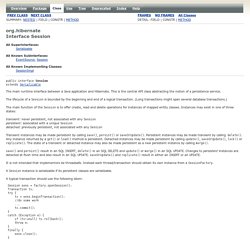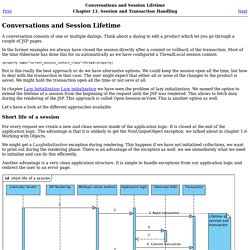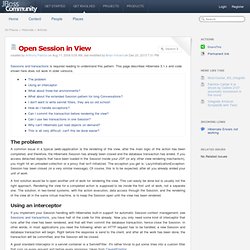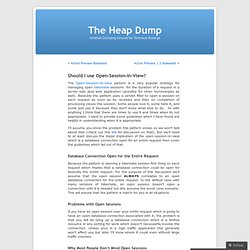

Session (Hibernate JavaDocs) All Superinterfaces: Serializable All Known Subinterfaces: EventSource, Session All Known Implementing Classes: SessionImpl public interface Sessionextends Serializable The main runtime interface between a Java application and Hibernate.

The lifecycle of a Session is bounded by the beginning and end of a logical transaction. The main function of the Session is to offer create, read and delete operations for instances of mapped entity classes. Transient: never persistent, not associated with any Session persistent: associated with a unique Session detached: previously persistent, not associated with any Session Transient instances may be made persistent by calling save(), persist() or saveOrUpdate(). Save() and persist() result in an SQL INSERT, delete() in an SQL DELETE and update() or merge() in an SQL UPDATE. It is not intended that implementors be threadsafe. Conversations and Session Lifetime.
A conversation consists of one or multiple dialogs.

Think about a dialog to edit a product which let you go through a couple of JSP pages. In the former examples we always have closed the session directly after a commit or rollback of the transaction. Most of the time Hibernate has done this for us automatically as we have configured a ThreadLocal session context. <property name="current_session_context_class">thread</property> But is this really the best approach or do we have alternative options. In chapter Lazy InitializationLazy initialization we have seen the problem of lazy initialization.
Let’s have a look at the different approaches available. For every request we create a new and clean session inside of the application logic. We might get a LazyInitialization exception during rendering. Another advantage is a very clean application structure. Let’s have a look at sample code. Dialog 1 We enter a dialog to edit a turtle. Dialog 2 Dialog 3. Hibernate: Ensuring Initialized Association Paths.
Open Session in View. Sessions and transactions is required reading to understand this pattern.

This page describes Hibernate 3.1.x and code shown here does not work in older versions. The problem A common issue in a typical (web-)application is the rendering of the view, after the main logic of the action has been completed, and therefore, the Hibernate Session has already been closed and the database transaction has ended. If you access detached objects that have been loaded in the Session inside your JSP (or any other view rendering mechanism), you might hit an unloaded collection or a proxy that isn't initialized. The exception you get is: LazyInitializationException: Session has been closed (or a very similar message). A first solution would be to open another unit of work for rendering the view.
Using an interceptor If you implement your Session handling with Hibernates built-in support for automatic Session context management, see Sessions and transactions, you have half of the code for this already. Open Session in View Pattern for Spring and JPA « Smartkey – Java Software Consultancy. The Open Session in View Pattern is a well publicised design pattern for Hibernate applications and is considered the best practice approach to presenting data within the Web tier of an application. In this article I’ll demonstrate how simple it is to configure a Spring application to work the same way when JPA is used for the persistence technology. The exact same principles apply for a plain Spring/Hibernate application that does not use JPA. What is Open Session in View? The Java Persistence API (JPA) allows an object oriented model to be mapped to a relational database.
JPA is a standard specification for Java based Object Relational Mapping frameworks – in order to use JPA an underlying implementation must be available; the most common choice being Hibernate. Both JPA an Hibernate support lazy loading of data to restrict the number of queries fired off to the database. Providing Request Scoped Transactions In web.xml: 01. 02. 03. 05. Should I use Open-Session-In-View? « The Heap Dump. The Open-Session-In-View pattern is a very popular strategy for managing open hibernate sessions for the duration of a request in a server side java web application (possibly for other technologies as well).

Basically the pattern uses a servlet filter to open a session on each request as soon as its received and then on completion of processing closes the session. Some people love it, some hate it, and some just use it because they don’t know what else to do. As with anything I think that there are times to use it and times when its not appropriate. I want to provide some guidelines which I have found are helpful in understanding when it is appropriate. I’ll assume you know the problem this pattern solves so we won’t talk about that (check out this link for discussion on that). Database Connection Open for the Entire Request Problems with Open Sessions Why Most People Don’t Mind Open Sessions Exceptions to the Trade Off.
Jpa - Why is hibernate open session in view considered a bad practice. Open Session In View Pattern.